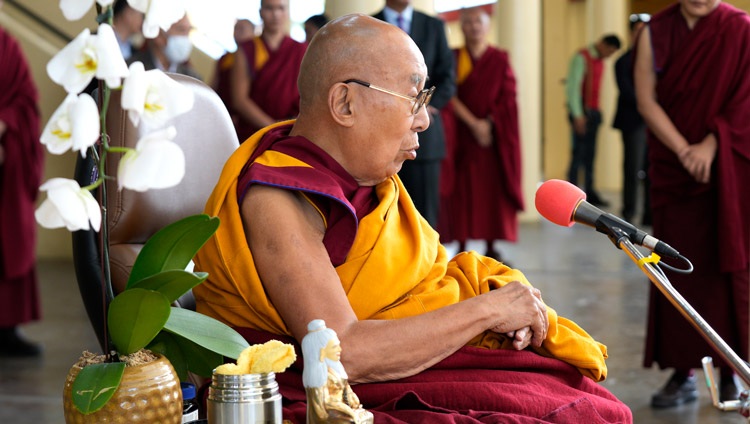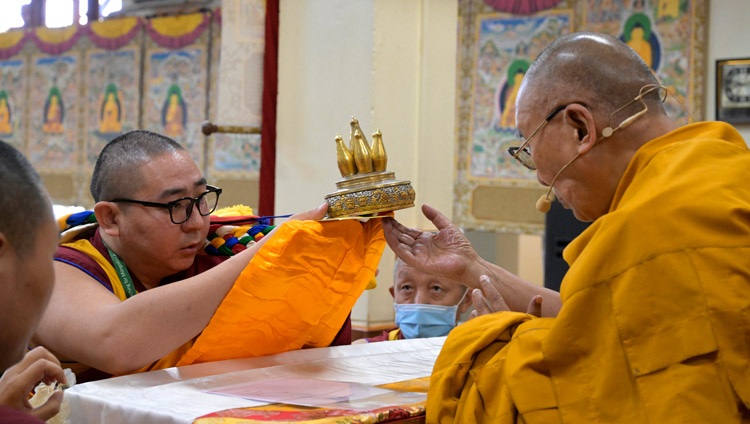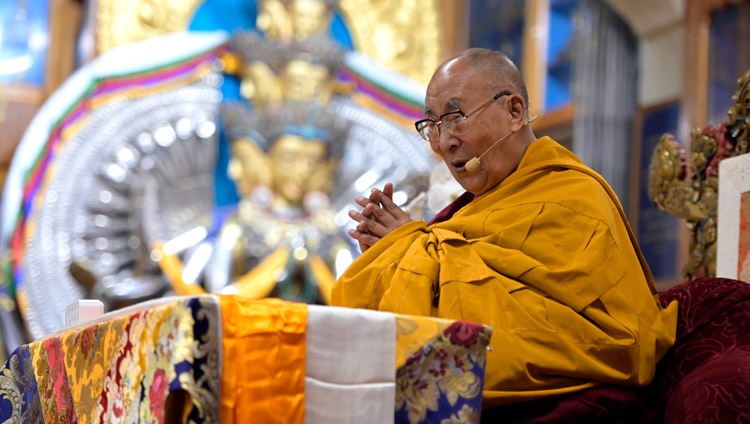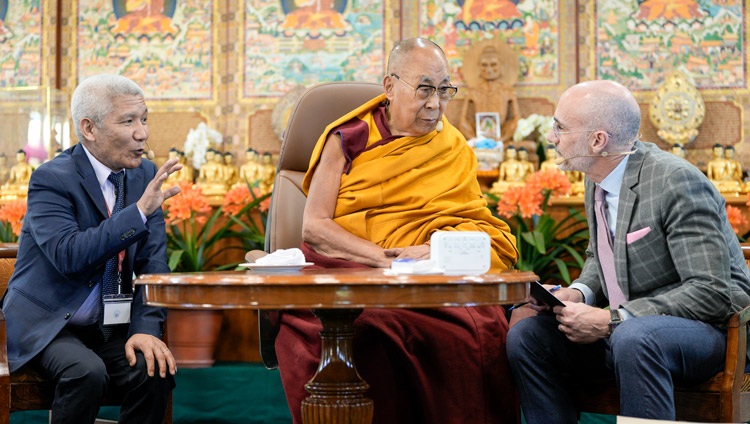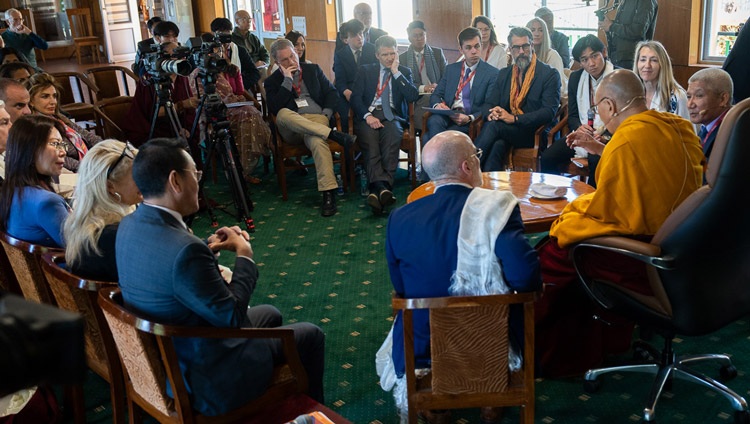Manjushri Cycle of Teachings Concludes
January 6, 2020
Bodhgaya, Bihar, India – This morning, on the final day of His Holiness the Dalai Lama’s current series of teachings, the sky was blue and the sun glinted off the golden ornaments on the roof of Ganden Phelgyeling as he set out for the Kalachakra Ground. As is his wont, he greeted as many devotees and members of the public as he could on the way. He spoke to some, waved to many and smiled at them all. When he reached the stage a second group of those who came top in competitions in memorization and poetic composition in South India were gathered to have their photograph taken with him.
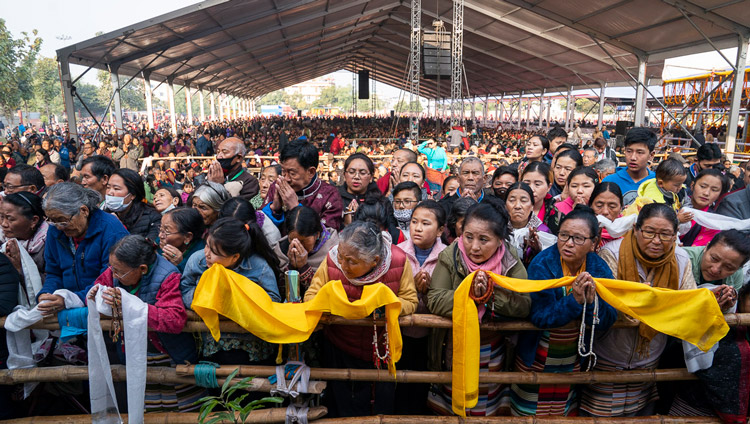
From the front of the stage the audience presented a sea of sunlit smiling faces and when His Holiness waved good morning, thousands of hands reached into the air to wave back. He then climbed onto the throne, saluted images of the Buddha and other great teachers and sat down. Immediately, the chant-masters, who have been serving the Great Prayer Festival for the last several days, launched into a stirring rendition of the ‘Heart Sutra’ in Tibetan.
“Today,” His Holiness announced, “the final permissions from the Manjushri Cycle of Teachings are for Inner, Outer and Secret Dharmaraja. First, I have to do the necessary preparatory practices and while I do that you can recite the ‘Praise to Dharmaraja’.
“We’ve all gathered in the special place, Bodhgaya, not for financial gain, but because we wanted to receive teachings. Within the division into teachings belonging to the general structure and specialized teachings, this belongs to the latter. Instructions about cultivating bodhichitta and so forth belong to the general structure. In addition to being specialized, the permissions I’m going to give today belong to Highest Yoga Tantra. They came about because the Buddha gave different teachings to different individuals and groups of people because of their differing mental dispositions.
“After the Buddha, great teachers like Nagarjuna and his followers had visions that gave rise to different traditions. Later, Naropa, who was once a scholarly gate-keeper at Nalanda University, left that role and entered into the life of a wandering yogin. He faced all kinds of difficulties, but also received profound instructions from Tilopa. There are some practices intended to be deployed to overcome obstacles and foes, of which this practice of fierce Dharmaraja is one.
“The foundation of our practice is the awakening mind of bodhichitta and a clear understanding of emptiness. Jé Tsongkhapa said, ‘I have to achieve the Truth Body and I will help others on the way. To overcome obstacles, I’ll rely on the protectors’. This is sometimes necessary, although the purpose is not to gain personal reward. However, it is said that if you can’t overcome obstacles by adopting a peaceful approach, use wrathful means.
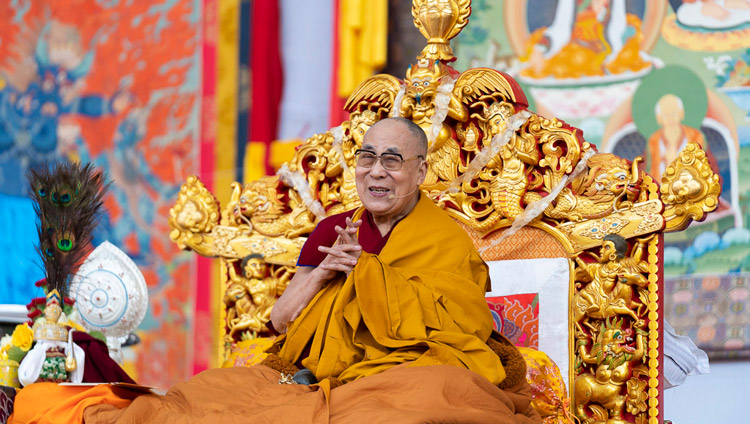
“Our motivation should be that from now until the attainment of enlightenment we will benefit others as much as possible. If we reflect on dependent arising, we can defeat self-centredness and our misconception of self. Working to overcome the self-cherishing attitude is both the path of practice and the path to teach others.
“I’ve done the preparations and, before that this morning, I met some Chinese devotees. I pointed out to them that Buddhism in China as well as in Tibet originated here in India. These days, China has the largest Buddhist population in the world.”
His Holiness disclosed that he does a Vajrabhairava retreat every year, as he promised Ling Rinpoché he would do. He added that Vajrabhairava was the first major empowerment he received as a child from Tagdrak Rinpoché and then much later it was the last empowerment he received from Ling Rinpoché.
He mentioned that he’d thought today to read Jé Rinpoché’s ‘Three Principal Aspects of the Path’, which he sent in the form of a letter to Tsako Wönpo, Ngawang Drakpa, a close disciple in Gyalmorong, Eastern Tibet.
His Holiness expressed his admiration for Tsongkhapa’s written works. He noted that the ‘Golden Rosary’ reflects Jé Rinpoché’s early understanding of emptiness. ‘The Great Treatise on the Stages of the Path’, the ‘Medium Treatise on the Stages of the Path’, the ‘Essence of Good Explanation’ and this ‘Three Principal Aspects of the Path’ reveal his mature understanding.
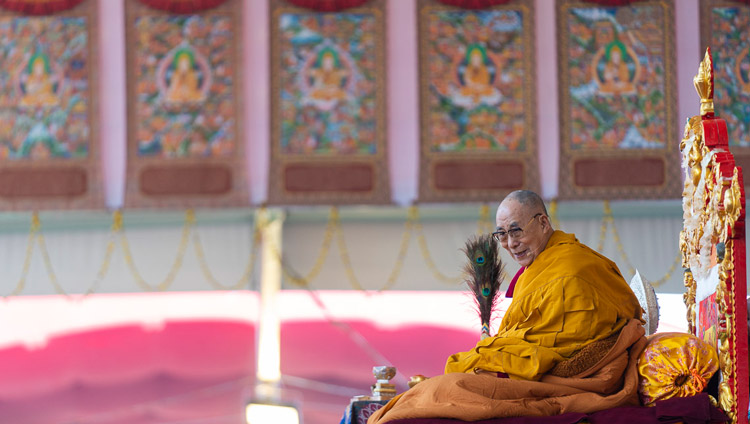
The three principals of the path referred to in the title are the determination to be free, the awakening mind of bodhichitta and the wisdom understanding emptiness. His Holiness explained that when he reflects on this text, he regularly transposes the emphasis of the seventh and eighth verses to strengthen the determination to be free.
Swept by the current of the four powerful rivers,
Tied by strong bonds of actions, so hard to undo,
Caught in the iron net of self-centredness,
Completely enveloped by the darkness of ignorance,
Born and reborn in boundless cyclic existence,
Ceaselessly tormented by the three miseries
I too am in this condition.
Thinking of this I generate a determination to be free.
The next verse makes clear that without realizing emptiness, you cannot cut the root of cyclic existence.
“We are facing great problems in the world today,” His Holiness declared. “There’s too much violence and killing. The climate crisis is becoming extreme. Fires that have swept across Australia and parts of Brazil have left great numbers of animals dead. On an individual level we can take steps to counter global heating.
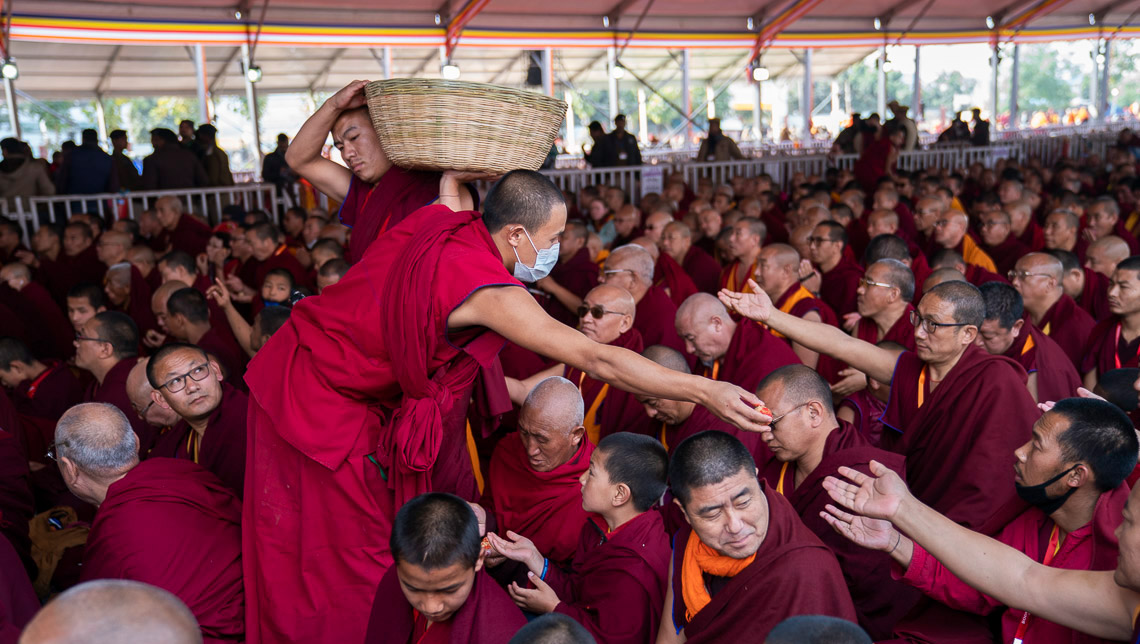
“The seventh and eighth verses are about cultivating bodhichitta, but we will only eliminate suffering by overcoming ignorance. Jé Rinpoché points out that understanding dependent arising and emptiness go together. When we understand emptiness, dependent arising is the underlying reasoning. We have to understand this to appreciate that things have no objective existence. However, ‘as long as these two understandings are seen as separate, you have not yet realized the intent of the Buddha’.
“Jé Rinpoché goes on to clarify that ‘when these two realizations are simultaneous and concurrent, from a mere sight of infallible dependent arising comes certain knowledge that completely destroys all modes of mental grasping. At that time the analysis of the profound view is complete’. To really understand emptiness, we have to overcome the two extremes, which is why he states, ‘Appearances refute the extreme of existence, emptiness refutes the extreme of nonexistence. When you understand the arising of cause and effect from the viewpoint of emptiness, you are not captivated by either extreme view’.
“Tsongkhapa’s final advice to Tsako Wönpo, Ngawang Drakpa is to ‘depend on solitude and strong effort, and quickly reach the final goal’. This applies equally to us too.
“In his own account of his life, Tsongkhapa wrote:
In the beginning I sought much learning,
in the middle the teaching dawned on me as spiritual instruction
and in the end, I strove day and night in practice.
I dedicate the merit that the Dharma may flourish.
“The key is to study, reflect and meditate on what you’ve understood. The aim is to incorporate all the teachings of the Buddha in a single practice.”
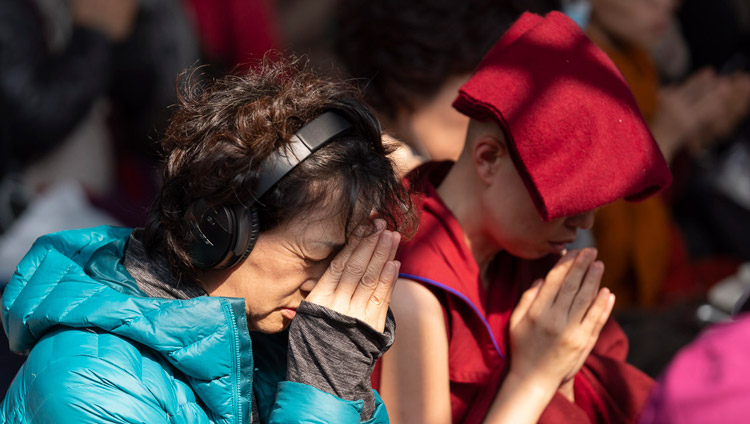
As he led the gathering in taking the bodhisattva vows once more, His Holiness pointed out that cultivating bodhichitta is the essence of the Buddha’s teaching. While giving the permissions, he elaborated on this, advising his listeners to cultivate bodhichitta as well as a clear understanding of emptiness and to do deity yoga. He remarked that if you can take the three bodies into the path, you’ll be prepared to take advantage of the mind of clear light that manifests at the time of death.
At the end of the session His Holiness declared his satisfaction that the series of teachings had been successfully completed. He noted that both those present with him in Bodhgaya and those attending to the teachings online had collected great merit. He recommended saying a prayer of general dedication, but also to make a dedication for the welfare of Tibet.
“Integrate the teachings within yourself and gradually transform your mind. This is the way to make your life meaningful.
“Things are impermanent. After being together it’s in the nature of things that we disperse. I won’t forget you. I’ll think of you. You in turn, don’t just think of our having been here physically together, think of my having given teachings, they are the basis for transforming yourselves. Nevertheless, you also need to be practical and remember that transformation doesn’t take place instantly. It takes time —weeks, months and years of practice. Keep this in mind and practise well.”
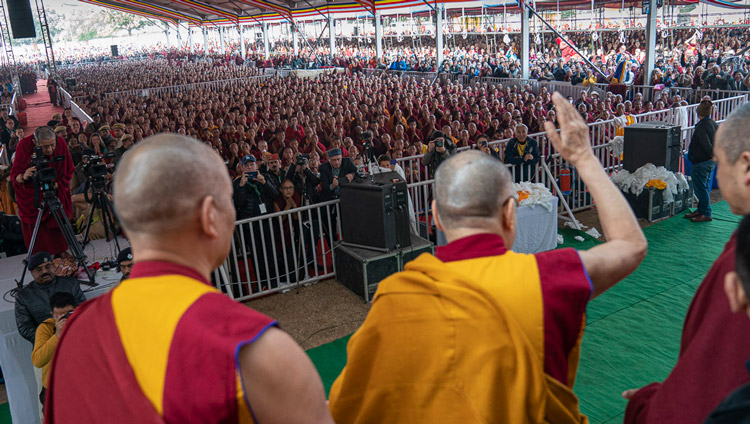
Finally, before His Holiness left the teaching ground a representative of the Teaching Organizing Committee and the Great Prayer Festival Committee each read out a statement of accounts. His Holiness waved goodbye to the crowd from the edge of the stage and even as he climbed into his car waved to more people who caught his eye. And with that he returned to Ganden Phelgyeling Monastery.
…………………………………………………………………………
SOURCE: Dalailama.com

